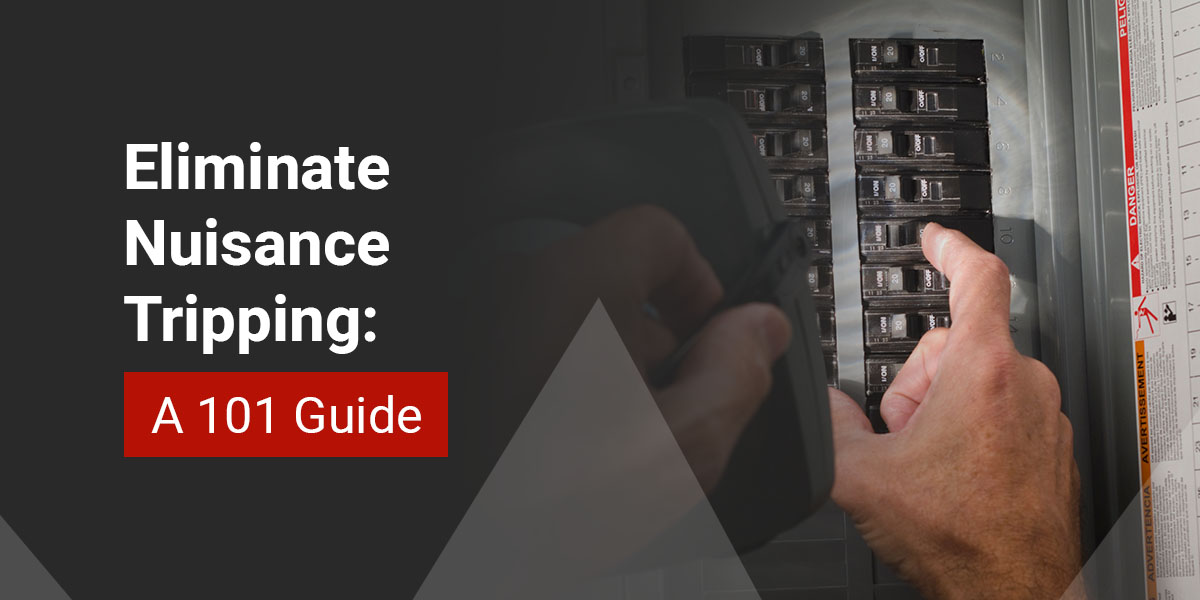As a facilities manager, you should regularly check your circuit breakers—after all, sometimes breakers can trip without being overloaded.
Nuisance tripping, also known as sympathetic tripping, happens when protective devices like circuit breakers or GFCIs shut off power unexpectedly without a real electrical fault or overload. It’s like a false alarm but can be costly and frustrating, especially in manufacturing, healthcare and other commercial or industrial facilities.
Nuisance tripping can disrupt operations and lead to excessive downtime, productivity loss, and even damage your reputation if it repeatedly occurs. In some cases, nuisance tripping can lead to penalties imposed by electric power regulators if in noncompliance with established utility liability metrics.
Fortunately, there are steps you can take to avoid disruption. But first, here are a few simple causes of nuisance tripping.
What Causes Nuisance Tripping?
As opposed to necessary or expected tripping, below are a few common causes of nuisance tripping:
Wear and tear
- Some protective devices contain electromechanical trip units to protect against overcurrents. As these devices wear and fatigue over time, they can impact the circuit breakers’ sensitivity and cause tripping.
Incorrect settings
- Since circuit breakers and relays have adjustable settings for overcurrent protection, incorrectly setting these parameters can cause breakers to trip unnecessarily.
Electromagnetic interference
- Sometimes, electromagnetic fields from nearby equipment or electrical systems can induce currents that can trip breakers.
Environmental factors
- Dust and contaminants, humidity or heat can also compromise the integrity of electrical systems and lead to false tripping.
Inrush currents
- Large motors, transformers or equipment starting up can draw high initial currents and cause temporary overloads. While these currents don’t generate permanent faults, circuit breakers can interpret them as short circuits and cause nuisance tripping.
Tips to Prevent Nuisance Tripping
You can implement several procedures internally to reduce the likelihood and impact of nuisance tripping but don’t go in alone.
The best course of action is to contact a professional NETA-accredited electrical testing and maintenance company like Power Products & Solutions. We’ll be able to test your electrical systems and maintain them to avoid unnecessary tripping in the future.
Schedule Breaker Testing at Your Facility Today
Give us a call at 704.573.0420 or contact us online to schedule breaker testing or preventive maintenance on your facility's electrical equipment.
While the solution to nuisance tripping can vary depending on the cause, here are a few best practices to avoid nuisance tripping that may be performed.
Use Appropriate Cable Lengths
Excessive cable lengths can cause to nuisance tripping by increasing ground fault leakage currents. To mitigate this issue, consider placing protective devices closer to the equipment they safeguard. This reduces the length of cable runs and minimizes the effects of electromagnetic interference.
Proper Sizing and Rating for Components
Always ensure electric circuits, wires, and protective devices are sized and appropriately rated to handle the anticipated load and operating conditions.
Routine Breaker Maintenance
Since bad wiring or other defects can cause tripping, regular circuit breaker maintenance at your facility is essential. Routine inspection and testing according to NFPA maintenance (70B) and workplace safety (70E) standards is the best way to properly diagnose and correct potential issues before false tripping occurs.
Environmental Controls
If environmental conditions are the root cause of nuisance tripping, you may need to consider better ventilation, corrosion-resistant materials or assess insulation integrity. While environmental stressors will impact many electrical systems over time, a routine maintenance plan can help prevent unnecessary tripping.
Coordinate Protective Devices
Improving protective device coordination is an excellent way to safeguard against overcurrent conditions that lead to nuisance tripping. Using selective tripping can help isolate the affected portion of the system while allowing the rest of the system to remain operational. You can also use time-delay settings to minimize nuisance tripping by ensuring an upstream device has adequate time to clear a fault before other devices are impacted.
Replace Damaged Breakers
If your circuit breakers keep tripping for no apparent reason, they may be malfunctioning units. While breakers may function for 30 to 40 years, the lack of timely preventative maintenance can shorten their life span and cause performance issues. NETA-certified electricians can inspect and protect the breakers and replace them if necessary.
Proper Installation and Acceptance Testing
While age and other variables can cause nuisance tripping in existing systems, you’ll want to ensure new equipment is properly installed and tested. Acceptance testing that includes coordination testing, functional testing, or other important checks and tests can diagnose potential issues as part of the commissioning process.
Prevent and Stop Nuisance Tripping Today
At Power Products & Solutions, we’re here to ensure your power systems operate as they should so you stay productive and interrupted. Our experienced and NETA-certified technicians will gladly help detect, correct and prevent nuisance tripping at your facility.
We provide our services throughout the Carolinas, including 24/7/365 emergency response.
Contact Power Products & Solutions today or give us a call at (704) 573-0420 to schedule service today.

